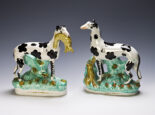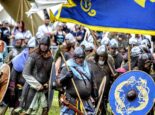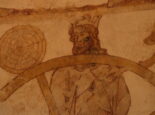Fotheringhay: A place of Royal Triumph and Tragedy
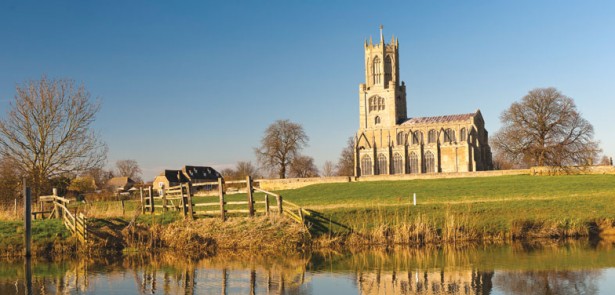
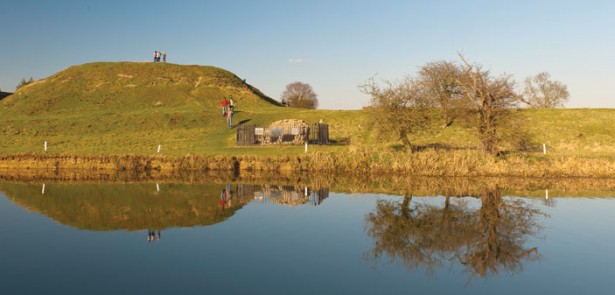

RICHARD GUNN visits Fotheringhay, the small Northamptonshire village that has played a large and complex role in British history
On 8 February, 1587, an event that forever changed the course of this country’s history took place. Mary, Queen of Scots, a cousin of and rival to Queen Elizabeth I for the English throne, was beheaded after 19 years in custody. The political and personal struggle between the two most powerful women in what had yet to become the United Kingdom had pitched England against Scotland and the Protestant religion against Roman Catholicism. In the eyes of her country and Catholics, Mary died a martyr, but to the English and Protestants she was a traitor. The repercussions of her execution resonated for decades, even centuries afterwards; indeed, to this day it remains a major part of the traditional rivalry between the two countries south and north of the border. Ironically, her death didn’t halt the ascendancy of the Scottish line of Stewarts to the Tudor-held seat of English power; it merely postponed it for 16 years. Mary’s son, James, would succeed the Virgin Queen, Elizabeth, in 1603 and finally unite the thrones of the two opposing nations, with the Royal Stewart dynasty lasting through to 1707.
 The power play between Elizabeth and Mary is infamous. Less well-known though is that its finale was acted out in what is now a very quiet, tiny and unassuming village just a few miles to the south-west of Peterborough. The Queen of Scots spent the final months of her life at Fotheringhay, in the impassive motte-and-bailey castle that once stood there beside the River Nene. Months later, her coffin was taken by torchlight procession to Peterborough Cathedral where it was entombed until King James I had her moved to Westminster Abbey in 1612. Her grave there is, incongruously, just 30 feet away from Queen Elizabeth’s.
The power play between Elizabeth and Mary is infamous. Less well-known though is that its finale was acted out in what is now a very quiet, tiny and unassuming village just a few miles to the south-west of Peterborough. The Queen of Scots spent the final months of her life at Fotheringhay, in the impassive motte-and-bailey castle that once stood there beside the River Nene. Months later, her coffin was taken by torchlight procession to Peterborough Cathedral where it was entombed until King James I had her moved to Westminster Abbey in 1612. Her grave there is, incongruously, just 30 feet away from Queen Elizabeth’s.
This event alone would cement Fotheringhay’s place in the history of Britain, but it is only one part of its political significance. Hundreds of years earlier, it was a place of major national importance, practically the Windsor of its day, as the stronghold of the House of Plantagenet. This was the dynasty that ruled England from 1154 to 1485. It spawned a total of 15 kings, starting with Henry II and ending with Richard III, Shakespeare’s favourite hunchbacked monarchical and maniacal villain, who was actually born in Fotheringhay. He died in 1485 at the Battle of Bosworth Field; the final English king to be killed at war. As he was without a legitimate heir, the throne passed to the Tudors of which Elizabeth I would be the last. Small wonder that Fotheringhay has been described as ‘distinguished beyond any other place in Britain, except the capital, by the aggravated misfortunes of Royalty’.
Hints of former importance
Today, aside from the scattered information boards that tell the story of the village’s past and the striking parish church of St Mary and All Saints, almost like a miniature cathedral in its architecture, there are few hints of Fotheringhay’s former importance. Although, in the late-middle ages, it contained the most impressive collection of buildings in the region, spread along several roads, and held a weekly market and annual fairs, the population is now around 125, mainly living in the old stone houses that border the sole existing street. There isn’t a single shop and only one pub, where once there were five. And all that now remains of the castle is a thistle-covered mound by the river and a single block of toppled masonry. But how many of its visitors, those who come by land and those who moor up there in barges and boats, realise the sheer scale and magnitude of events that happened centuries earlier just a few feet away?
Although traces of prehistoric, Roman and Saxon settlements have been found around Fotheringhay, the first real reference to the village dates back to 1060. Then, it was known as Fodringeya, although by 1075, it was noted as Frodrigeya and a few years later in the Domesday Book, it was being called Fodringeia. The name of Fotheringhay – or Fotheringay, with the final ‘H’ dropped – didn’t emerge until the 17th century. It is believed that the village’s title derives from ‘the island of the people of Forthere’ as ‘eg’ or ‘ey’ means island in old English and is commonly used throughout the fens. However, a 16th century account also attributed the name as representing an enclosure of Rockingham Forest – which then stretched for 700 square miles of Northamptonshire – used for producing hay for deer.
The Domesday Book recorded Fotheringhay as being the property of Countess Judith, niece of William the Conqueror and the widow of the Earl of Huntingdon. There were 25 tenants, 19 villeins (a class of feudal surf), six borders, three slaves and a priest. It was Judith’s son-in-law, Simon de Senlis, who built the first wooden castle there, around 1100, to control the river crossing on a now lost main road from London to Stamford. The fortress was surrounded by two moats, with the River Nene providing the defence on the southern side. Simon also founded a Cluniac nunnery in the village, although it survived only four years before being moved to Delapre near Northampton. In an ironic twist, given what would happen in Fotheringhay almost half a millennium later, the estate became a possession of the Royal House of Scotland in 1109 after Simon died and his wife, Maud, married King David I of Scotland.
The only significant military action the castle saw was during a siege in 1220-21 when rebellious baron, William de Fortibus, the Earl of Albermarle, took it by surprise from John le Scot. His cunning plan was to send his forces across the moat, which just happened to be frozen at the time. He turned it into a garrison and plundered the surrounding area. However, it returned back to the Scottish crown after William married the niece of the owner he’d conquered it from. Its days as Royal Scottish property finally came to an end in 1294 when it was legally seized back for England by King Edward I during a dispute with King John I of Scotland.
After passing through the hands of Mary of Valence, the Countess of Pembroke responsible for establishing Pembroke College in Cambridge, it was given by King Edward III to his fifth son, Edmund Plantagenet of Langley, in 1387. This Earl of Cambridge had become the first Duke of York in 1385, founding the powerful House of York that would later become embroiled in the Wars of the Roses for the throne, against the House of Lancaster.
Fotheringhay is ‘distinguished beyond any other place in Britain, except the capital, by the aggravated misfortunes of Royalty.’
Restoration and foundation
Edmund restored the run-down castle to a habitable state and also set to planning the pithily-titled Collegiate Church of the Annunciation and St Edward the Confessor within the Castle of Fotheringhay. This secular college wasn’t an educational establishment as such, but a form of monastery of Canons, ruled by a Dean or Provost. Edmund probably intended it to rival his father’s great colleges at Westminster and Windsor. However, he died in 1402, and in 1410 his son Edward decided to move the proposed college away from the castle and to the more spacious grounds of the nearby parish church. Eventually, this renamed Collegiate Church of St Mary and All Saints would grow to the size of a cathedral. Edward didn’t live to see much of it completed though; he was killed at the Battle of Agincourt in 1415 and buried in the quire of the partially-completed structure. Fewer than 20 years later, construction also began on a new parish church to match the splendour of the now-completed college. William Horwod, a local freemason, was awarded the £300 contract to build it, but would only be paid if he did it satisfactorily. If he didn’t, he would be thrown in prison instead. Quite some incentive to turn in a good job…
By now, Fotheringhay was the property of Richard, Duke of York, who would father King Edward IV and King Richard III. Although he owned vast amounts of land, Fotheringhay was said to be one of his favourite residences, and he founded a grammar school alongside the collegiate church. Like the first Duke of York, he too would be killed in battle, at Wakefield in 1460, along with his third son, Edmund, Earl of Rutland. They were also buried at the new church in Fotheringhay, albeit after spending six years interred in rather grim and mean tombs in Pontefract. Their elaborate funeral was attended by Edward and his queen, and the future Richard III, who was then the Duke of Gloucester. The dinner that followed was attended by 20,000 people, according to contemporary accounts. It took place at the castle and in tents and temporary pavilions throughout the village. Total cost came to over £300, a massive amount for those days, and included capons, cygnets, herons and rabbits. The church is reputedly haunted by replays of the funerals of both the Dukes of York, with ghostly medieval music often heard emanating from inside despite nobody being there.
Duke of York, who would father King Edward IV and King Richard III. Although he owned vast amounts of land, Fotheringhay was said to be one of his favourite residences, and he founded a grammar school alongside the collegiate church. Like the first Duke of York, he too would be killed in battle, at Wakefield in 1460, along with his third son, Edmund, Earl of Rutland. They were also buried at the new church in Fotheringhay, albeit after spending six years interred in rather grim and mean tombs in Pontefract. Their elaborate funeral was attended by Edward and his queen, and the future Richard III, who was then the Duke of Gloucester. The dinner that followed was attended by 20,000 people, according to contemporary accounts. It took place at the castle and in tents and temporary pavilions throughout the village. Total cost came to over £300, a massive amount for those days, and included capons, cygnets, herons and rabbits. The church is reputedly haunted by replays of the funerals of both the Dukes of York, with ghostly medieval music often heard emanating from inside despite nobody being there.
Richard III, Shakespeare’s favourite hunchbacked monarchical and maniacal villain, was born in Fotheringhay
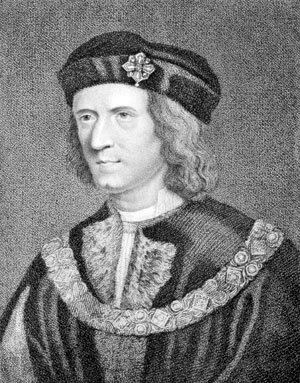 The man who would become Richard III had been born at Fotheringhay Castle on 2 October, 1452, and although he died at the age of only 32 and was king for only two years, he remains one of the most controversial and notorious of all British monarchs. This is mainly due to his negative portrayals by William Shakespeare, Sir Thomas More and Polydore Vergil, written many years after his death. Shakespeare in particular would most cement Richard III’s enduring but far from endearing image as a jealous and evil sovereign, with a withered arm, limp and crooked back, who murdered his 10- and 13-year-old nephews in the Tower of London so he could seize the throne. Whatever the truth – and many believe the king was innocent in the Princes in the Tower case – with iconic utterances such as “Now is the winter of our discontent” and “A horse, a horse, my kingdom for a horse” awarded to him by The Bard of Avon, Richard III is now much more famous than his two-year reign might otherwise have merited. The first six years of his life were spent at Fotheringhay before the clashes of the Wars of the Roses caused him to be moved to the safety of Ludlow Castle instead. When he was defeated and killed at the battle of Bosworth Field in 1485, it signalled the end of the Wars of the Roses and effectively the middle ages as well, ushering in the Tudor era under King Henry VII.
The man who would become Richard III had been born at Fotheringhay Castle on 2 October, 1452, and although he died at the age of only 32 and was king for only two years, he remains one of the most controversial and notorious of all British monarchs. This is mainly due to his negative portrayals by William Shakespeare, Sir Thomas More and Polydore Vergil, written many years after his death. Shakespeare in particular would most cement Richard III’s enduring but far from endearing image as a jealous and evil sovereign, with a withered arm, limp and crooked back, who murdered his 10- and 13-year-old nephews in the Tower of London so he could seize the throne. Whatever the truth – and many believe the king was innocent in the Princes in the Tower case – with iconic utterances such as “Now is the winter of our discontent” and “A horse, a horse, my kingdom for a horse” awarded to him by The Bard of Avon, Richard III is now much more famous than his two-year reign might otherwise have merited. The first six years of his life were spent at Fotheringhay before the clashes of the Wars of the Roses caused him to be moved to the safety of Ludlow Castle instead. When he was defeated and killed at the battle of Bosworth Field in 1485, it signalled the end of the Wars of the Roses and effectively the middle ages as well, ushering in the Tudor era under King Henry VII.
Fotheringhay also became Tudor property as well, after the death of Cecily, the Duchess of York, in 1497. Henry VII gave it to his wife, Elizabeth of York, and his successor Henry VIII also bestowed it on each of his six wives, taking it back each time he divorced or executed them (although number three and personal favourite Jane Seymour did die of natural causes after giving birth to the future Edward VI). His first wife, Catherine of Aragon, spent a considerable amount of money on improving the castle, which had declined considerably after the end of the Plantagenets. The king himself probably visited the castle, with fifth wife Catherine Howard, in 1541 while travelling north to avoid the plague in London.
The fall of the college
The collegiate church, however, had a much less fortunate time of things under the most infamous of the Tudor kings. Henry VIII fell out with the Roman Catholic Church after the Pope refused to annul his  marriage to Catherine of Aragon so he could marry Anne Boleyn instead. He declared himself supreme head of the Church of England in 1534 and started the dissolution of the monasteries, stripping them of their wealth and power. The college was surrendered to the Crown in 1539. Soon afterwards, an inventory recorded that it held lands in Northamptonshire, Lincoln, Gloucester, Huntingdonshire, Middlesex, Rutland, Suffolk and Worcester and also boasted 1,450 oz of plate, jewels, manuscripts and 93 chained books in its library. However, it continued to function much as before, until 1548 when it was granted to John Dudley, Duke of Northumberland. He immediately moved to strip it of its content, including removing the roof for its lead and selling off the furniture. Some of this can still be seen in nearby religious establishments at Tansor, Hemington and King’s Cliffe. While the parish church was left standing and the grammar school also survived, the attached college fell into ruin, gradually disappearing completely over the next few centuries. Its location now is occupied by the graveyard and a plain, empty field rolling down to the river. From above though, the outlines of the old buildings can still be made out. The Duke of Northumberland met his own end not long afterwards, being decapitated at the Tower of London in 1553 for his role in trying to unsuccessfully install Lady Jane Grey on the English throne. She ruled for a mere nine days.
marriage to Catherine of Aragon so he could marry Anne Boleyn instead. He declared himself supreme head of the Church of England in 1534 and started the dissolution of the monasteries, stripping them of their wealth and power. The college was surrendered to the Crown in 1539. Soon afterwards, an inventory recorded that it held lands in Northamptonshire, Lincoln, Gloucester, Huntingdonshire, Middlesex, Rutland, Suffolk and Worcester and also boasted 1,450 oz of plate, jewels, manuscripts and 93 chained books in its library. However, it continued to function much as before, until 1548 when it was granted to John Dudley, Duke of Northumberland. He immediately moved to strip it of its content, including removing the roof for its lead and selling off the furniture. Some of this can still be seen in nearby religious establishments at Tansor, Hemington and King’s Cliffe. While the parish church was left standing and the grammar school also survived, the attached college fell into ruin, gradually disappearing completely over the next few centuries. Its location now is occupied by the graveyard and a plain, empty field rolling down to the river. From above though, the outlines of the old buildings can still be made out. The Duke of Northumberland met his own end not long afterwards, being decapitated at the Tower of London in 1553 for his role in trying to unsuccessfully install Lady Jane Grey on the English throne. She ruled for a mere nine days.
The village was visited by Queen Elizabeth I in 1573, who was shocked to see the desecrated tombs of her Royal ancestors amid the wrecked remains of the collegiate church. She ordered that they be reinterred inside the parish church, with twin monuments erected on the eastern wall. She also arranged for the local schoolmaster to be paid a salary of £20 per annum and commanded the decrepit old wooden bridge across the River Nene, adjacent to the castle, to be replaced. It had been noted as long before as 1330 that it was ‘broken so that hardly any winter passes without danger of death in passing there.’ Elizabeth’s one was much stronger, with stone piers and wooden decking. However, the inscription that accompanied it, proclaiming ‘God Save the Queen’ was obliterated by Cromwell’s Parliamentarian troops during the civil war of 1642 to 1651. The stained glass of the church would also have been at risk during their march through the village, had not the local minister bribed them to leave it unscathed. Elizabeth’s bridge survived until 1722, when it was rebuilt completely in stone. This remains in use today.
Elizabeth’s stopover wasn’t completely beneficial for Fotheringhay though. The bill for hospitality was so great that it bankrupted the local Molesworth family. And she perhaps also took note of Fotheringhay Castle as potentially a suitable prison for her cousin, Mary, Queen of Scots, who had then only been in ‘protective custody’ for five years.
Mary had originally come to England expecting Elizabeth to help her with her political struggles. She had become queen at just six days old, in 1542, as the only surviving child of King James V of Scotland. She spent much of her early life within the French court, for reasons of personal safety, where she was noted for her beauty, cleverness and height (5 foot 11 inches was exceptionally lofty for the era). The well-educated Mary married Francis, the son of King Henry II of France, when she was just 16. Following the death of Queen Mary I of England in 1558, she claimed a right to the crown instead of her cousin Elizabeth, who legally succeeded to it. In the view of Catholics, Elizabeth was illegitimate and therefore not the true heir; Mary was.
She returned to Scotland to rule that nation in 1561, following the death of her husband. There were attempts at appeasement with Elizabeth, but they came to nothing. Although personal discussions between the two great regal rivals were mooted, they never materialised; the queens would never meet in person.
‘Being punished in a world like this,
I’ve earned my portion in eternal bliss’:
Mary, Queen of Scots, on the eve of her execution
Mary wed Lord Darnley, Henry Stuart, in 1565, a move that further angered Elizabeth because he too had a strong entitlement to the English crown. Darnley’s involvement in the murder of David Rizzio, Mary’s private secretary, in 1566 doomed the marriage though; he was jealous of their relationship and the killing was carried out in front of the pregnant Mary. The plot led to political unrest in Scotland; Darnley himself was assassinated in 1567, and Mary’s failed attempts to quell the uprisings against her caused her to flee to England a year later. She expected Elizabeth to help her regain Scotland but the cautious queen instead kept her under house arrest in a variety of castles while her involvement in the death of Darnley was investigated. However, when evidence emerged of an international plot to depose Elizabeth using Spanish troops and replace her with Mary, the Queen of Scots’ fate was sealed.
Mary and Fotheringhay
She was brought to Fotheringhay on 25 September, 1586, supposedly exclaiming “I perish” when she saw the grim and foreboding castle that would be her final prison. A trial was held there on 14 and 15 October, with the Lord High Treasurer, William Cecil of nearby Burghley House in Stamford, leading the prosecution. She was found guilty of treason. Some believed much of the information that condemned her was fabricated by Sir Francis Walsingham and the newly-crea ted English Secret Service; certainly she contested her innocence spiritedly. “Remember that the theatre of the world is wider than the realm of England” was one of her more famous quotations during her defence. But even lines like that were to no avail. However, Elizabeth still hesitated about confirming the execution. The death warrant didn’t receive her signature until February 1, 1587, with the queen later claiming that she’d signed it in error when it was given to her hidden amid a stack of less important papers. The privy councillor she’d entrusted the warrant to was subsequently thrown into the Tower of London.
ted English Secret Service; certainly she contested her innocence spiritedly. “Remember that the theatre of the world is wider than the realm of England” was one of her more famous quotations during her defence. But even lines like that were to no avail. However, Elizabeth still hesitated about confirming the execution. The death warrant didn’t receive her signature until February 1, 1587, with the queen later claiming that she’d signed it in error when it was given to her hidden amid a stack of less important papers. The privy councillor she’d entrusted the warrant to was subsequently thrown into the Tower of London.
All this had little relevance to Mary though. Her execution was quickly arranged, and she was only told it was going to take place the day before. She spent her final hours praying and writing her will, with one of the requests being that she be buried in France. She also composed a sonnet which has been passed down through history.
‘And you, my friends, who have loved me so true,
Remember, lacking health and heart and peace,
There is nothing worth-while I can do;
Ask only that my misery cease.
Being punished in a world like this,
I’ve earned my portion in eternal bliss.’
On 8 February, the 44-year old monarch was led to the great hall of the castle, atop the raised mound, where she was beheaded. The death was botched; the axeman taking two or three attempts to sever her head. Afterwards, those in attendance were shocked to see her robes still moving; her small dog had hidden underneath the voluminous garments and refused to leave the body. It was eventually dragged away by the queen’s ladies-in-waiting and had to be repeatedly washed to get all the blood off it.
“Remember that the theatre of the world is wider than the realm of England”
This momentous and harrowing event signalled the end of Fotheringhay’s major role in British history, as if it was tainted by what had taken place there. Ownership of the castle passed to James I when he united England and Scotland after Elizabeth’s demise, in 1603. But he must have had little taste for the place that had seen such tragedy for his mother. By 1635, it was deserted and going to ruin, not long afterwards it was demolished altogether. Popular legend has it that James ordered its destruction as an act of revenge, but as he died in 1625, this is unlikely to be true, unless his wishes were carried out by a loyal subject. Stone and fittings were used for building throughout the local area, with the most famous item – the great staircase, up which Mary walked her last steps – going to the Talbot Inn at Oundle. Such was the tension in her final moments that she allegedly pressed her ring so hard into the banister that the mark of its crown insignia is still there. The ring was later found on the castle site in 1820 when some of its stone was being stripped for farm repairs; it’s believed that it rolled off during her death throes and was swept away unnoticed. It can now be seen in the Victoria and Albert Museum in London. Meanwhile, Mary’s ghost is said to still haunt the staircase at the Talbot Inn, replaying her final journey…
Decline and obscurity
As the castle sank into obscurity, so the village declined with it. In 1524, there were about 100 families living in Fotheringhay. By 1673, after the castle had gone, this had dropped to 67, and by 1801, there were only 57. In more recent years, that figure fell to just 40 households. By 1902, even the church itself was almost derelict, but a campaign to restore this important example of Perpendicular religious architecture, led by the Bishop of Peterborough, saved it by raising £5,000.
The estate of Fotheringhay passed from the Crown through several private hands, including those of Hewer Edgeley Hewer, the godson and heir to the fortune of William Hewer, Samuel Pepys’ manservant, frequently mentioned in his diaries. In 1920, it was broken up and the individual farms, properties and lands sold to their tenants. The remains of the castle continued to disappear, bit by bit. In 1864, the then-o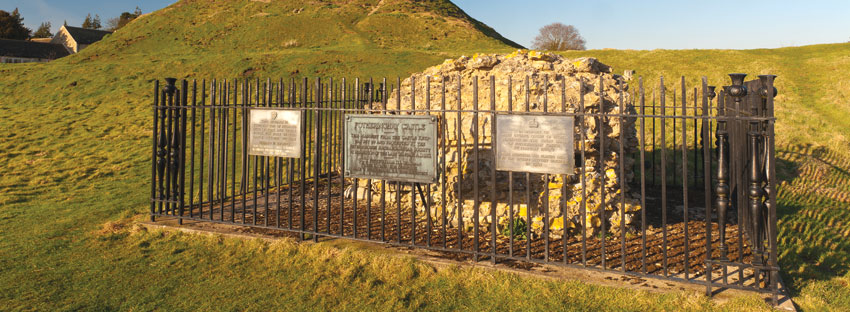 wner, prominent banker Lord Overstone, removed the final traces of the walls. Now all that remains are the mound, traces of the moat, and just a section of tumbled stonework. It is enclosed by railing, with plaques marking the two most significant events that occurred there; the birth of Richard III and the death of Mary of Scotland. Sheep now are the main residents of a spot once occupied by kings and queens.
wner, prominent banker Lord Overstone, removed the final traces of the walls. Now all that remains are the mound, traces of the moat, and just a section of tumbled stonework. It is enclosed by railing, with plaques marking the two most significant events that occurred there; the birth of Richard III and the death of Mary of Scotland. Sheep now are the main residents of a spot once occupied by kings and queens.
 It has become a place of pilgrimage for those with an interest in both these fascinating but tragic rulers from two once-opposing nations. Richard’s birthday (2 October) is commemorated annually by the placing of white roses – the symbol of the House of York – in the church by the Richard III Society. This is an organisation dedicated to trying to prove that Richard wasn’t quite the resolutely bad guy that Shakespeare et al painted him. And, starting in 1901, Scotsman Theodore Napiere would travel down from his homeland every year to lay a crown-shaped wreath on the spot where Mary was executed. Dressed in full Highland garb, his annual visit on 8 February – the date of her death – would draw quite a crowd, until complaints that he was trespassing on land not then open to the public caused him to stop. He died in Australia in 1924. Many of his fellow countrymen and women have made similar trips since; less public, more private perhaps, but still paying their own tribute to one of Scotland’s most famous and melancholy figures. The mound on which the great hall once stood is now, appropriately, covered by thistles, something that has been attributed to Theodore Napiere.
It has become a place of pilgrimage for those with an interest in both these fascinating but tragic rulers from two once-opposing nations. Richard’s birthday (2 October) is commemorated annually by the placing of white roses – the symbol of the House of York – in the church by the Richard III Society. This is an organisation dedicated to trying to prove that Richard wasn’t quite the resolutely bad guy that Shakespeare et al painted him. And, starting in 1901, Scotsman Theodore Napiere would travel down from his homeland every year to lay a crown-shaped wreath on the spot where Mary was executed. Dressed in full Highland garb, his annual visit on 8 February – the date of her death – would draw quite a crowd, until complaints that he was trespassing on land not then open to the public caused him to stop. He died in Australia in 1924. Many of his fellow countrymen and women have made similar trips since; less public, more private perhaps, but still paying their own tribute to one of Scotland’s most famous and melancholy figures. The mound on which the great hall once stood is now, appropriately, covered by thistles, something that has been attributed to Theodore Napiere.
Fotheringhay today is a beautiful and serene small village, nestling on the banks of the River Nene, far removed from the modern world. Few vehicles pass down its hushed main street, well away from any main roads. But its present tranquillity also seems at odds with its tumultuous and momentous past. Where once a Royal castle loomed over the local landscape, now there is only the church’s distinctive 103-feet tall tower dominating the skyline. The footprints of ancient Royals are now trod in by day-trippers and resident cattle, while the spot where Mary died – one of this country’s most notorious and significant historical events – is little more than a pleasant picnic spot, offering spectacular views over the River Nene and surrounding countryside. But visit, explore and dig deeper into the fabric of Fotheringhay and its fascinating story gradually unfolds; a place of incredible importance that both made kings and broke queens…












